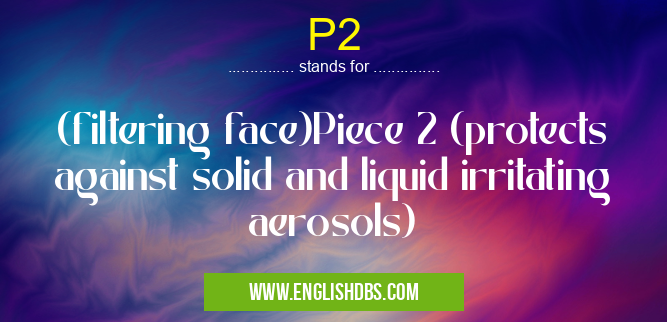What does P2 mean in PREVENTION
P2 is a type of face filtering equipment designed to protect against solid and liquid irritating aerosols. It is typically used in industrial workplaces and settings where hazardous materials are present. As safety is paramount, it's important to understand the purpose of P2 face protection and how to properly use it.

P2 meaning in Prevention in Medical
P2 mostly used in an acronym Prevention in Category Medical that means (filtering face)Piece 2 (protects against solid and liquid irritating aerosols)
Shorthand: P2,
Full Form: (filtering face)Piece 2 (protects against solid and liquid irritating aerosols)
For more information of "(filtering face)Piece 2 (protects against solid and liquid irritating aerosols)", see the section below.
» Medical » Prevention
Essential Questions and Answers on (filtering face)Piece 2 (protects against solid and liquid irritating aerosols) in "MEDICAL»PREVENTION"
What is P2 face protection?
P2 face protection is a type of mask or respirator designed to provide physical protection from solid and liquid irritants like aerosols or mist. It typically has two straps that go around the head for a snug fit, as well as an adjustable nose clip for added security when worn correctly. The filter material can be made up of several layers including activated carbon for gas-based particles, non-woven fabrics for dust particles, and an exhaust valve for easy exhalation.
Why do I need to wear P2 face protection?
Wearing P2 face protection can protect your respiratory system from exposure to harmful particles in the air like chemicals, dust, smoke or other allergens. Depending on the workplace environment and potential risks present, using this type of facial covering can help protect workers from certain health risks associated with airborne irritants.
How often should I change my P2 face protection?
Generally speaking, it's recommended that you change your P2 face mask or respirator after each 8-hour shift if you've been exposed to hazardous materials such as dust, smoke or chemicals. Additionally, you should always inspect your mask before using it and discard it if there are any signs of damage or wear and tear.
Does wearing a P2 face protector help reduce COVID-19 transmission?
While wearing a P2 face protector may not completely eliminate the risk of contracting COVID-19 due to its potential airborne transmission method, utilizing this form of facial covering along with other prevention techniques like social distancing can help reduce the spread of the virus significantly when done consistently.
Where can I find affordable options for a good quality P2 facemask?
You can usually find good quality and affordable options for protective facemasks online by searching through specialized websites dedicated to safety products such as masks or respirators. Additionally, many major retail stores also offer different types of protective gear which can be suitable for use in professional settings if necessary.
Final Words:
All in all, using proper protective gear like a high quality P2 facemask is essential in order ensure worker safety when dealing with hazardous materials that require extra measures beyond ordinary personal protective equipment (PPE). Understanding how these types of devices work and what their limitations are will help ensure that workers remain safe regardless of the environment they are working in.
